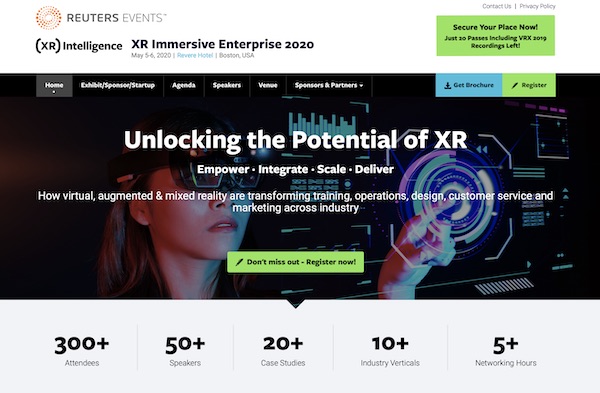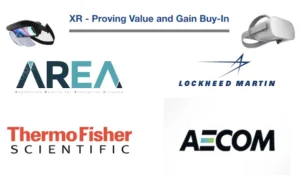Some time ago I reported on a webinar organized by Reuters Events and the AREA (Augmented Reality for Enterprise Alliance). They have had a second webinar focusing on the XR value (ROI) and how to gain buy-in in a large enterprise. All these webinars are a lead up to the CR Immersive Enterprise Conference, which will take place on May 5-6, 2020 in Boston, MA.

If you are looking into XR and its use within your company, this conference may be worth a look. You can find more information on their website.
 Upcoming conference: XR Immersive Enterprise 2020
Upcoming conference: XR Immersive Enterprise 2020
In most cases, introducing a new technology into a company requires some push as well as a lot of convincing of the stakeholders of the potential benefits. An important step in convincing management that this is a worthwhile endeavor, comes from the ROI this technology promises. In the beginning this is mainly driven by plans rather than achieved savings. As the company starts to use XR technologies the ROI question becomes more of a hard number rather than wishful thinking. As a consequence of a good return, the buy-in of all the stakeholders is becoming increasingly easier. Who does not want to save money?
The webinar discussed these topics from the very different perspectives of three large global companies in addition to his general statements, Mark Sage, Executive Director of AREA said that in their survey of companies that have XR technologies deployed, 93% of companies using VR and 88% of companies using AR and MR see a positive effect on their business.
Lockheed Martin
The aerospace company is using XR technologies for more than six years in various applications. Shelley Peterson (Prinicipal Investigator for Augmented and Mixed Reality) said that they are using these technologies in building air- and spacecraft. In general, XR helps in speeding up timelines and mitigating schedule risks. They started very small and have introduced these technologies to the users within their company after they were sure that the technology would benefit them.
When introduced they let the users have input on how to improve the applications leading to better buy-in by the actual users. This equates to more of a bottom-up approach rather than a top-down introduction. In general they do see drastic reductions in labor costs, which were in a range of 20% to 30% for the first three use cases they explored. As an example they save per attachment of any part (cables, sensors, etc.) to the aircraft an average of $38. Lockheed Martin creates about 2 million attachments per year. You do the math.
In their case they dO not see any use for using tablets and smartphones, but are using more advanced headsets. This makes a lot of sense considering the industry they are in. Interestingly they stated that they see the XR technologies developing much faster than they originally expected. Not quite the impression people in consumer applications are expressing.
They are developing their software applications in house, which may be driven by the proprietary nature of their business. They also said that they can develop some of the content faster than the established methods leading to faster schedules and lower labor costs.
In terms of key points of their implementation, they said that understanding the technology and the end users is very important in the technology roll out. Taking the time to develop a sensible roadmap with low initial investments helps in the long run to establish a good return on investments. They also stressed that they learned a lot from other companies’ implementation experiences.
AECOM
This global architecture, engineering and construction company is using XR in various ares within their company. Stephen Paul (Visualization and Immersive Technology Director) observed that XR is used successfully in three areas, marketing, building information management, and collaboration. The three areas are quite different and require different solutions and hardware.
While marketing activities are benefiting from consumer products like Google cardboard and smartphones, other areas require more sophisticated hardware. They put a lot of VR content on the web to allow consumers to view these images and videos with their own VR devices. In planning buildings they explained that using VR helps to visualize certain aspects of buildings that otherwise can get easily lost. For example, they mentioned a childrens’ hospital where VR allowed the planners to review the hospital at the height of a child or a person sitting in a wheelchair. It helped to avoid early design mistakes. This is of course creating cost savings, however they did not provide hard numbers.
Another example was winning a project and helping the customer to make a better decision in the planning phase. They could show alternative building designs to customers without creating any kind of models. Being on the forefront of the technology in this case may help them to win a project over company that cannot provide the same visualization technology.
They also develop all their applications in-house. They said that they are using a small team that develops all their apps in-house with no need to outsource any development. They do use Unreal Engine for their apps.
Their key point was a focus on communication with their audience to manage expectations and develop the right thing in the first place. If they find that an implementation does not deliver the desired results based on XR technology limitations, they suggest waiting, as XR technology is getting better all the time.
Thermo Fisher Scientific
The scientific instruments, consumables and services company is still exploring various areas for XR implementations. Earl F. Sison (Sr. Designer Digital VR + AR Development) said they are using XR in three main areas. There is training / education, remote service, as well as sales force support and general marketing activities. While the training and remote service functions can be judged by hard ROI numbers, the same is not true for sales support and marketing. While these implementations may lead to more sales, this is typically due to a number of reasons and not just because you have a VR headset. In the marketing efforts it can be challenging to sell the XR applications in house to the stakeholders, making buy-in a more difficult tasks compared to actual cost saving as in some of the other applications.
They did not have any hard numbers for the ROI but see the use of XR at this point in time as a demonstration of market leadership compared to their competitors, an advantage that will evaporate as more and more companies use this technology as well. In other ares they saw a direct reduction of accidents in a factory after using XR-based safety training. That’s certainly a measurable result that translates easily enough into actual savings.
Thermo Fisher has all software applications developed outside of the company, as this is more cost effective to keep the XR team as small as possible. In contrast to the other presenters, their applications do not change as frequently. Once a certain application is developed it is used by many people without changes.
Their key points are communication with actual users and their input on the software design process. It is very important to anticipate the questions the potential users might have and giving them the answer immediately helps in creating buy-in for CR technology.
Companies talking about ROI and buy-in in XR technologies
All in all the companies gave a real good overview of different applications and the potential of XR technologies in enterprises. For sure these companies are quite large and, as such, open for trying out new things just to stay ahead. In all cases the implementation strategies were quite low key and based on small groups within their organizations to feel out what can be achieved with these technologies. It seems that all three companies are continuing their XR adoption, a good sign for sure. – NH

